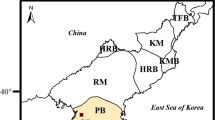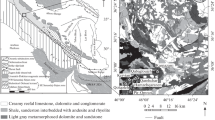Abstract
This paper describes a GIS-based application of a fuzzy analytical hierarchy process (AHP) to map porphyry-Cu prospectivity in the Dananhu metallogenic belt, NW China. Based on a model of porphyry-Cu mineralization, evidential layers were derived from geological, geochemical, and geophysical data. These layers were subsequently assigned weights by implementing a fuzzy AHP method using knowledge from three experts in porphyry-Cu exploration. After obtaining normalized weights, different fuzzy operators were tried to combine the weighted evidential layers into potential maps, which were then compared and evaluated by predication-area (P-A) plots. Subsequently, a ternary map was generated by defuzzification of the optimum prospectivity map as selected by the P-A plot; this ternary map shows zones of high, moderate, and low favorability for porphyry-Cu deposits in the study area. To further evaluate the results, potential zones were analyzed for two-dimensional spatial domain. The results demonstrate that the fuzzy AHP method can be effectively applied to mineral prospectivity mapping in vaguely known areas.







Similar content being viewed by others
References
Abedi M, Norouzi GH, Fathianpour N (2013a) Fuzzy outranking approach: a knowledge-driven method for mineral prospectivity mapping. Int J Appl Earth Obs Geoinf 21:556–567
Abedi M, Torabi SA, Norouzi GH (2013b) Application of fuzzy AHP method to integrate geophysical data in a prospect scale, a case study: seridune copper deposit. Boll Geofis Teor Appl 54:145–164
Agterberg FP, Bonham-Carter GF (1999) Logistic regression and weights of evidence modeling in mineral exploration. In: Proceedings APCOM ‘99, Colorado School of Mines. Golden, Colorado
Albayrak E, Erensal Y (2004) Using analytic hierarchy process (AHP) to improve human performance: an application of multiple criteria decision making problem. J Intell Manuf 15:491–503
An P, Moon WM, Rencz A (1991) Application of fuzzy set theory for integration of geological, geophysical and remote sensing data. Can J Explor Geophys 27:1–11
Bonham-Carter GF (1994) Geographic information systems for geoscientists: modeling with GIS. Pergamon Press, Oxford
Buckley JJ (1985) Fuzzy hierarchical analysis. Fuzzy Sets Syst 17:233–247
Carranza EJM (2008) Geochemical anomaly and mineral prospectivity mapping in GIS. In: Handbook of exploration and environmental geochemistry. Elsevier, Amsterdam, p 368
Carranza EJM (2010) Improved wildcat modelling of mineral prospectivity. Resour Geol 60:129–149
Carranza EJM (2014) Evidential belief predictive modeling of mineral prospectivity using few prospects and evidence with missing values. Nat Resour Res. doi:10.1007/s11953-014-9250-z
Carranza EJM, Hale M (2001) Logistic regression for geologically constrained mapping of gold potential, Baguio district, Philippines. Explor Min Geol 10:165–175
Carranza EJM, Hale M (2002) Wildcat mapping of gold potential, Baguio district, Philippines. Appl Earth Sci 111:100–105
Carranza EJM, Hale M (2003) Evidential belief functions for data-driven geologically constrained mapping of gold potential, Baguio district, Philippines. Ore Geol Rev 22:117–132
Carranza EJM, Mangaoang JC, Hale M (1999) Application of mineral exploration models and GIS to generate mineral potential maps as input for optimum land-use planning in the Philippines. Nat Resour Res 8:165–173
Chang D (1996) Applications of the extent analysis method on fuzzy AHP. Eur J Oper Res 95:649–655
Chen Y (2006) Mineral resource and metallogenetic system in Tianshan, China. Geological Press, Beijing (in Chinese)
Cheng Q (2007) Mapping singularities with stream sediment geochemical data for prediction of undiscovered mineral deposits in Gejiu, Yunnan Province, China. Ore Geol Rev 32:314–324
Cheng Q, Agterberg F, Ballantyne S (1994) The separation of geochemical anomalies from background by fractal methods. J Geochem Explor 51:109–130
Dagdeviren M (2008) Decision making in equipment selection: an integrated approach with AHP and PROMETHEE. J Intell Manuf 19:397–406
Dong L, Feng J, Liu D, Tang Y, Qu X, Wang K, Yang Z (2010) Research for classification of metallogenic unit of Xinjiang. Xinjiang Geol 28:1–15 (in Chinese)
Feizizadeh B, Blaschke T (2013) Land suitability analysis for Tabriz County, Iran: a multi-criteria evaluation approach using GIS. J Environ Plan Manag 56:1–23
Feizizadeh B, Roodposhti MS, Jankowski P, Blaschke T (2014) A GIS-based extended fuzzy multi-criteria evaluation for landslide susceptibility mapping. Comput Geosci 73:208–221
Han C, Xiao W, Zhao G, Mao J, Wang Z, Yan Z, Mao Q (2006) Geological characteristics and genesis of the Tuwu porphyry copper deposit, Hami, Xinjiang, Central Asia. Ore Geol Rev 29:77–94
Ji H, Sun J (2011) Discussion on characteristics and metallogenic epoch of Chihu Cu–Mo deposits in Hami, Xinjiang. Acta Miner Sin S:595–596 (in Chinese)
Karimi AR, Mehrdadi N, Hashemian SJ, Nabi-Bidhendi GR, Tavakkoli-Moghaddam R (2011) Using of the fuzzy TOPSIS and fuzzy AHP methods for wastewater treatment process selection. Int J academic res 3:737–745
Knox-Robinson CM (2000) Vectorial fuzzy logic: a novel technique for enhanced mineral prospectivity mapping, with reference to the orogenic gold mineralisation potential of the Kalgoorlie Terrane, Western Australia. Aust J Earth Sci 47:929–941
Lindsay MD, Betts PG, Ailleres L (2014) Data fusion and porphyry copper prospectivity models, southeastern Arizona. Ore Geol Rev 61:120–140
Liu D, Chen Y, Wang D, Tang Y, Zhou R, Wang J, Li H, Chen F (2003) A Discussion on problems related to mineralization of Tuwu-Yandong Cu-Mo orefield in Hami, Xinjiang. Miner Depos 22:334–344 (in Chinese)
Liu Y, Cheng Q, Xia Q, Wang X (2014) Mineral potential mapping for tungsten polymetallic deposits in the Nanling metallogenic belt, South China. J Earth Sci 25:689–700
Liu Y, Cheng Q, Xia Q, Wang X (2015) The use of evidential belief functions for mineral potential mapping in the Nanling belt, South China. Front Earth Sci 9:342–354
Mao J, Goldfarb RJ, Wang Y, Hart CJ, Wang Z, Yang J (2005) Late Paleozoic base and precious metal deposits, East Tianshan, Xinjiang, China: Characteristics and geodynamic setting. Episodes 28:23–30
Najafi A, Karimpour MH, Ghaderi M (2014) Application of fuzzy AHP method to IOCG prospectivity mapping: a case study in Taherabad prospecting area, eastern Iran. Int J Appl Earth Obs Geoinf 33:142–154
Parsa M, Maghsoudi A, Yousefi M, Sadeghi M (2016) Prospectivity modeling of porphyry-Cu deposits by identification and integration of efficient mono-elemental geochemical signatures. J Afr Earth Sci 114:228–241
Pazand K, Hezarkhani A, Ghanbari Y (2014) Fuzzy analytical hierarchy process and GIS for predictive Cu porphyry potential mapping: a case study in Ahar-Arasbaran Zone (NW, Iran). Arab J Geosci 7:241–251
Porwal A, Carranza EJM, Hale M (2003a) Artificial neural networks for mineral potential mapping: a case study from Aravalli Province, Western India. Nat Resour Res 12:155–171
Porwal A, Carranza EJM, Hale M (2003b) Knowledge-driven and data-driven fuzzy models for predictive mineral potential mapping. Nat Resour Res 12:1–25
Rui Z, Wang L, Wang Y, Liu Y (2002a) Discussion on metallogenic epoch of Tuwu and Yandong porphyry copper deposits in East Tianshan Mountains, Xinjiang. Miner Depos 21:16–22 (in Chinese)
Rui Z, Liu Y, Wang L, Wang Y (2002b) The eastern Tianshan porphyry copper belt in Xinjiang and its tectonic framework. Acta Geol Sin 76:83–94 (in Chinese)
Saaty TL (1980) The analytic hierarchy process, planning, piority setting, resource allocation. McGraw-Hill, New York
Singer DA, Kouda R (1996) Application of a feedforward neural network in the search for Kuroko deposits in the Hokuroku district, Japan. Math Geol 28:1017–1023
Van Laarhoven PJM, Pedrycz W (1983) A fuzzy extension of Saaty’s priority theory. Fuzzy Sets Syst 11:199–227
Wang F, Feng J, Hu J, Wang L, Jiang L, Zhang Z (2001) The characteristics and significance of Tuwu large-type porphyry copper deposit in Xinjiang. Chin Geol 28:36–39+29 (in Chinese)
Wang Y, Luo Y, Hua Z (2008) On the extent analysis method for fuzzy AHP and its applications. Eur J Oper Res 186:735–747
Wang Y, Xue C, Liu J, Wang J, Yang J, Zhang F, Zhao Z, Zhao Y, Zhao Y, Liu B (2015) Early Carboniferous adakitic rocks in the area of the Tuwu deposit, eastern Tianshan, NW China: slab melting and implications for porphyry copper mineralization. J Asian Earth Sci 103:332–349
Wu H, Li H, Chen F, Lu Y, Deng G, Mei Y, Ji H (2006) Zircon SHRIMP U-Pb dating of plagiogranite porphyry in the Chihu molybdenum-copper district, Hami, East Tianshan. Geol bull Chin 25:549–552 (in Chinese)
Xiao F (2013) Mineral resource asseaament in covered area: a case study from “Tuwu-type” porphyry Cu-Mo deposits in Gobi desert landscape of eastern Tianshan, China. Ph.D. thesis, China University of Geosciences, Wuhan, China (in Chinese)
Xie X, Mu X, Ren X (1997) Geochemical mapping in China. J Geochem Explor 60:99–113
Xu R (2000) Fuzzy least-squares priority method in the analytic hierarchy process. Fuzzy Sets Syst 112:395–404
Yousefi M, Carranza EJM (2014) Data-driven index overlay and Boolean logic mineral prospectivity modeling in greenfields exploration. Nat Resour Res. doi: 10.1007/s11053-014-9261-9.
Yousefi M, Carranza EJM (2015a) Fuzzification of continuous-value spatial evidence for mineral prospectivity mapping. Comput Geosci 74:97–109
Yousefi M, Carranza EJM (2015b) Geometric average of spatial evidence data layers: a GIS-based multi-criteria decision-making approach to mineral prospectivity mapping. Comput Geosci 83:72–79
Yousefi M, Carranza EJM (2015c) Prediction-area (P-A) plot and C-A fractal analysis to classify and evaluate evidential maps for mineral prospectivity modeling. Comput Geosci 79:69–81
Yousefi M, Nykänen V (2015) Data-driven logistic-based weighting of geochemical and geological evidence layers in mineral prospectivity mapping. J Geochem Explor doi:10.1016/j.gexplo.2015.10.008
Zhang L, Xiao W, Qin K, Zhang Q (2006) The adakite connection of the Tuwu-Yandong copper porphyry belt, eastern Tianshan, NW China: trace element and Sr-Nd-Pb isotope geochemistry. Miner Depos 41:188–200
Zhu Y, Wang F, Long B, Xue Y, Xiao K, Feng J, Zhuang D, Jiang L (2003) Polygenic information prospecting model for Tuwu-Yandong porphyry Cu-Mo deposits. Miner Depos 22:287–294 (in Chinese)
Zhuang D (2003) The geochemical characteristics and anomoly verification methods of Tuwu and Yandong copper-deposits in the eastern Tianshan mountains, Xingjiang. Geol Prospect 39:67–71 (in Chinese)
Zhuang D, Wang S, Jiao X (2003) The predicting model of the synthetic information on Tuwu and Yandong copper orefield. Xinjiang Geol 21:293–297 (in Chinese)
Zuo R (2011) Regional exploration targeting model for Gangdese porphyry copper deposits. Resour Geol 61:296–303
Zuo R, Cheng Q, Agterberg FP, Xia Q (2009) Application of singularity mapping technique to identify local anomalies using stream sediment geochemical data, a case study from Gangdese, Tibet, western China. J Geochem Explor 101:225–235
Acknowledgments
The authors thank anonymous reviewers for their constructive comments and suggestions. This research benefited from the support from major projects in the Xinjiang Uygur Autonomous Region (201330121-3), Cooperative program of Chinese Academy of Sciences and Local Government (the science and technology program aims to support the development of Xinjiang), National Basic Research Program of China 973 Program (2014CB440803), Funded projects for the western Dr. (XBBS201203), and 100 Talents Program of Xinjiang.
Author information
Authors and Affiliations
Corresponding author
Rights and permissions
About this article
Cite this article
Du, X., Zhou, K., Cui, Y. et al. Application of fuzzy analytical hierarchy process (AHP) and prediction-area (P-A) plot for mineral prospectivity mapping: a case study from the Dananhu metallogenic belt, Xinjiang, NW China. Arab J Geosci 9, 298 (2016). https://doi.org/10.1007/s12517-016-2316-y
Received:
Accepted:
Published:
DOI: https://doi.org/10.1007/s12517-016-2316-y




